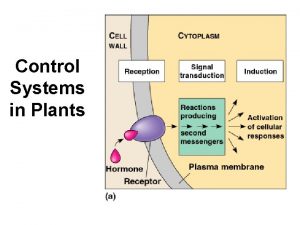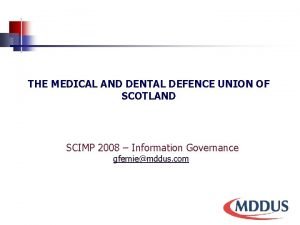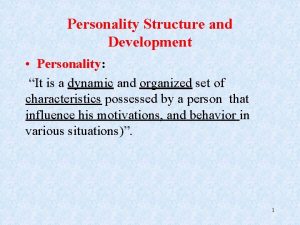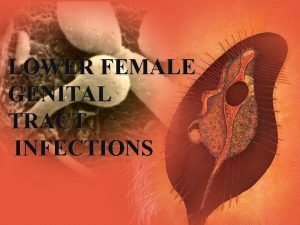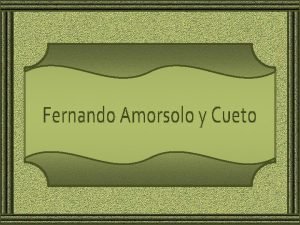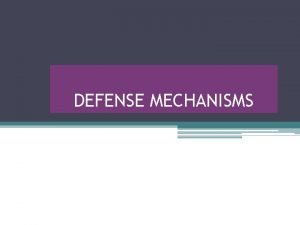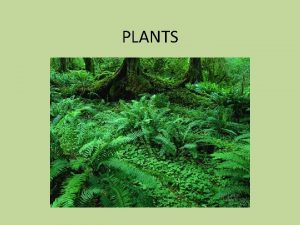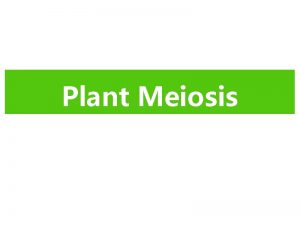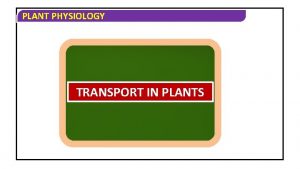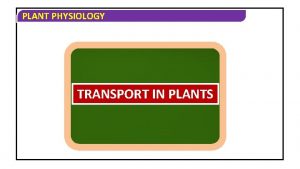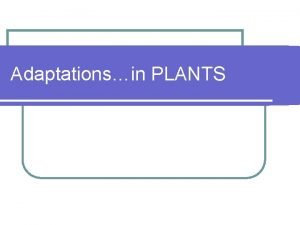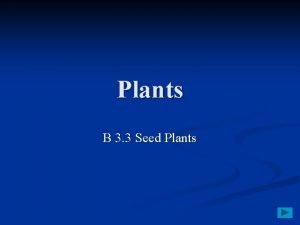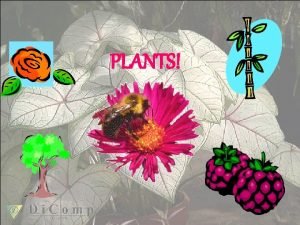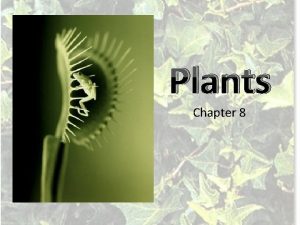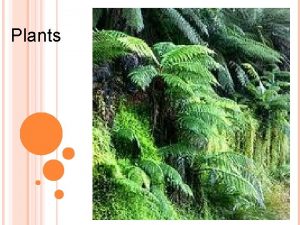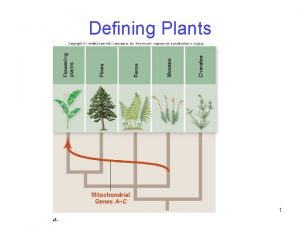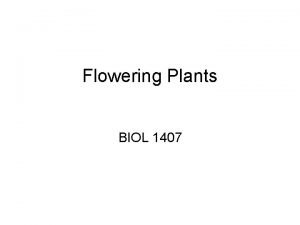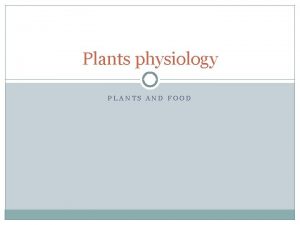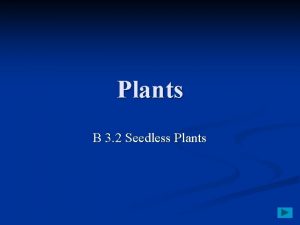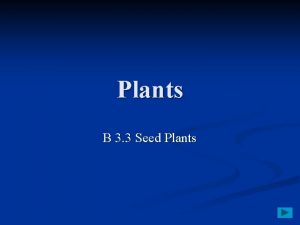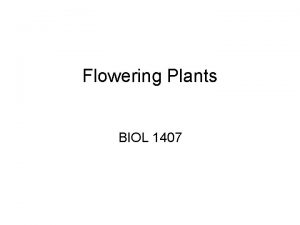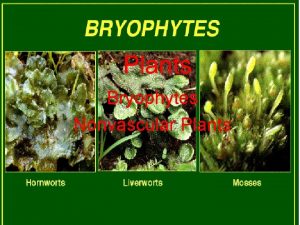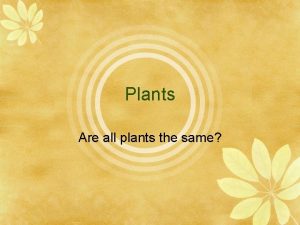Plant Defence Systems Plant Defence Systems Plants are



































- Slides: 35

Plant Defence Systems

Plant Defence Systems • Plants are sessile, i. e. they can’t move from place to place. • They need some defences against herbivores that might want to eat them, and against pathogens. • Plants counter these by both physical and chemical defences.

Physical Plant Defences

Thorns • These are modified branches, usually formed from the axil of the leaf, e. g. a hawthorn.

Spines • These are modified leaves, e. g. found in gooseberry. • In an extreme case, the cactus, all the leaves are turned into spines and photosynthesis is taken over by the stem. • Sometimes the spines are kept to the outside of the leaf. E. g. holly

Spines • In holly we find that the leaves near the bottom of the tree, within reach of the browsers, have the most spines – those at the top of the tree have almost completely lost them.

Prickles • These are outgrowths of the superficial tissue of the stem. • E. g. roses and blackberry

Stings • These are modified hairs, found on plants such as the stinging nettle. • The hair has a rounded base containing secretory cells that make an irritating fluid containing histamine and acetyl choline. • The top of the hair ends in a small rounded tip that breaks off when touched by an animal’s skin and the fluid is injected.

Low Growing Points • Many plants can tolerate being grazed by having their growing points very low on the ground where the herbivores can’t eat it. • This means the plant is able to keep on growing. • E. g. grasses and dandelions.

Divarication • These plants branch at wide angles with closely interlaced branches, forming a tangled mass. • Often the outer branches have smaller, fewer leaves than the inner branches, which are protected from the browsers.

Enclosing Seeds in a Hard Coat or Prickles • This is a good and obvious way to deter predators. • E. g. Swan plants

Seed Masting • This is the simultaneous release of all the seeds by all the trees of the same species in an area, at intervals of 2 years or more. • The advantage is that most of the time there are not enough seeds to support a large population of seed-eating animals. • When the seeds are shed, the animals present can’t possibly eat them all so a large number of seeds survive.

Hiding • There are some plants, found in Southern Africa, called Stone Plants, that are the colour and shape of the stones amongst which they grow. • Thus they are completely camouflaged until they flower.

Waxy Cuticle and Epidermis • The main barrier against the invasion of pathogens is the leaf epidermis. • Viruses and other pathogens can only enter through a break in it or through the stomata. • The worst vectors of pathogens are sapsucking animals which pierce the epidermis and insert their proboscis into the sap.

Waxy Cuticle and Epidermis • They then fly to another leaf, carrying with them viruses, fungal spores and bacteria. • E. g. aphids, passionfruit vine hoppers and green shield bugs

Trapping • Some chemicals are sticky, and would-be eaters. • The Parapara has sticky seeds that can entrap small birds so they cannot fly.

Chemical Defences

Chemical Defences • Plants produce some extremely toxic substances, yet they themselves are not poisoned by these chemicals. • It has been established that these chemicals are kept in vacuoles and are only released when the leaf is chewed or pierced.

Chemicals Used Against Pathogens • Antibiotics – once a pathogen invades a plant, it sets up a chemical attack. – the infected plant starts to produce chemicals called Phytoalexins. – These are antibiotics which kill or inhibit the pathogens

Chemicals Used Against Pathogens • Caffeine – This is the main stimulant in coffee, tea and in some painkillers. – This is extracted from the coffee tree beans. – In the plant, it has a physiological effect on fungi.

Chemicals Used Against Pathogens • Chillies – Very good antibiotics – Have a “hot” taste to put off mammals

Common Chemicals that Deter Insects • Canavanine – This is a defence against chewing insects. – It is an amino acid which resembles arginine. – When the insect eats it the Canavanine becomes incorporated into the insects proteins instead of arginine and the insect dies.

Common Chemicals that Deter Insects • Cyanogenesis – This is the production of cyanide. – In the wild cherry, some grasses and some varieties of white clover. – When tissues of these plants are damaged by insects or snails, a non-poisonous glycoside is changed by an enzyme to the poisonous hydrogen cyanide. – Some animals produce enzymes that convert this poison to harmless thiocyanate.

Common Chemicals that Deter Insects • Pungent and Volatile Chemicals – The smells given off by onions, garlic and mustards are thought to stop insects from even landing on the plants.

Common Chemicals that Deter Insects • Pyrethrins – Some chrysanthemums produce a chemical in their leaves that is very poisonous to insects, preventing them from eating the leaves. – The caterpillars of certain moths and butterflies have developed an enzyme that can detoxify the pyrethrin, and these can eat the leaves unharmed.

Common Chemicals that Deter Insects • Tannins – In oak leaves and camellia act to stop insects eating their leaves. • Alkaloids – These are bitter tasting, thus prevent insects from eating them. Found in the Deadly Nightshade.

Common Chemicals that Deter Insects • Phenols – These are also thought to deter insects. They are very good germicides – used in hospitals. • Strychnine – This is produced by plants of the strychnos family

Common Chemicals that Deter Insects • Morphine – This comes from the opium poppy. • Nicotine – This is produced in the tobacco plant • Digitoxin – This is made in the common foxglove.

Common Chemicals that Deter Insects • Others – Some secondary compounds that are not poisonous to humans but may put off insects. – E. g. peppermint, cinnamon and cloves.

Poisons Incorporated into the Body of Insects • These can deter the predators of caterpillars. • E. g. the Monarch butterfly caterpillars have become tolerant of the poisons in the swan plant. As they eat these poisons accumulate and make the caterpillars’ own tissues unpleasant for a bird to eat.


Chemical Mimics • Tropical Sedge makes a chemical like the juvenile growth hormone of insects. • If the insects eat the plant they turn into deformed adults with twisted wings and unformed ovaries.

Chemical Mimics • The hairy wild potato gives out a chemical that mimics the alarm call of aphids, so they avoid the plant. • Some clovers are able to make a chemical that mimics oestrogen, thus causing fertility problems in herbivores that might eat them.

Sending Warnings • Scientists have discovered that willows and alders can communicate by airborne chemical cues. • In response to attack by insects, trees develop insect resistant chemicals. • If one tree is attacked, trees a fair way away respond by developing the insectresistant chemical as well.

Companion Planting • Marigold roots secrete a chemical that kills nematodes. • This helps the plants growing nearby. • Garlic planted in rose gardens is thought to keep aphids away.
 Mikael ferm
Mikael ferm How does moss reproduce
How does moss reproduce Non vascular vs vascular plants
Non vascular vs vascular plants Characteristic of non flowering plants
Characteristic of non flowering plants C3 plants vs c4 plants
C3 plants vs c4 plants How plants are named
How plants are named Control systems in plants
Control systems in plants Objective of plant breeding
Objective of plant breeding Taichum
Taichum Plant introduction in plant breeding
Plant introduction in plant breeding Tronsmo plant pathology and plant diseases download
Tronsmo plant pathology and plant diseases download Tronsmo plant pathology and plant diseases download
Tronsmo plant pathology and plant diseases download Albugo eye
Albugo eye University of defence brno
University of defence brno Castration
Castration Examples of ego defense mechanisms
Examples of ego defense mechanisms Medical defence union of scotland
Medical defence union of scotland 3 lines of defence
3 lines of defence Mohammedan anglo oriental defence association 1893
Mohammedan anglo oriental defence association 1893 Jung psychodynamic theory
Jung psychodynamic theory Splitting defense mechanism example
Splitting defense mechanism example Example of freud theory
Example of freud theory Sublimimation
Sublimimation National civil defence college
National civil defence college Nanosystems in security and defence
Nanosystems in security and defence Tinedazole
Tinedazole Gaisce.ie
Gaisce.ie Fernando amorsolo spouse
Fernando amorsolo spouse Evaluation of self defence
Evaluation of self defence What are defense mechanisms according to freud?
What are defense mechanisms according to freud? Intoxication defence
Intoxication defence Defence travel system
Defence travel system Waheeda prism
Waheeda prism Adfelps test
Adfelps test Australian defence force school of languages
Australian defence force school of languages Defence centre for languages and culture
Defence centre for languages and culture






